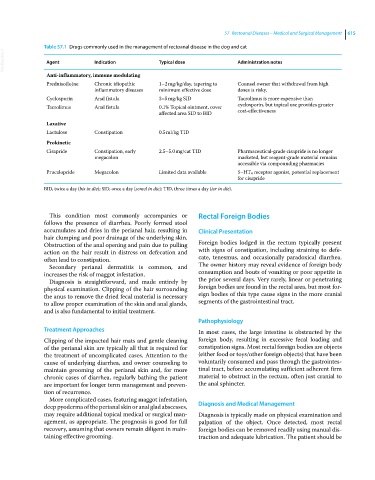Page 647 - Clinical Small Animal Internal Medicine
P. 647
57 Rectoanal Diseases – Medical and Surgical Management 615
Table 57.1 Drugs commonly used in the management of rectoanal disease in the dog and cat
VetBooks.ir Agent Indication Typical dose Administration notes
Anti-inflammatory, immune modulating
Predniso(lo)ne Chronic idiopathic 1–2 mg/kg/day, tapering to Counsel owner that withdrawal from high
inflammatory diseases minimum effective dose doses is risky.
Cyclosporin Anal fistula 3–5 mg/kg SID Tacrolimus is more expensive than
Tacrolimus Anal fistula 0.1% Topical ointment, cover cyclosporin, but topical use provides greater
affected area SID to BID cost-effectiveness
Laxative
Lactulose Constipation 0.5 ml/kg TID
Prokinetic
Cisapride Constipation, early 2.5–5.0 mg/cat TID Pharmaceutical‐grade cisapride is no longer
megacolon marketed, but reagent‐grade material remains
accessible via compounding pharmacies
Prucalopride Megacolon Limited data available 5–HT 4 receptor agonist, potential replacement
for cisapride
BID, twice a day (bis in die); SID, once a day (semel in die); TID, three times a day (ter in die).
This condition most commonly accompanies or Rectal Foreign Bodies
follows the presence of diarrhea. Poorly formed stool
accumulates and dries in the perianal hair, resulting in Clinical Presentation
hair clumping and poor drainage of the underlying skin.
Obstruction of the anal opening and pain due to pulling Foreign bodies lodged in the rectum typically present
action on the hair result in distress on defecation and with signs of constipation, including straining to defe-
often lead to constipation. cate, tenesmus, and occasionally paradoxical diarrhea.
Secondary perianal dermatitis is common, and The owner history may reveal evidence of foreign body
increases the risk of maggot infestation. consumption and bouts of vomiting or poor appetite in
Diagnosis is straightforward, and made entirely by the prior several days. Very rarely, linear or penetrating
physical examination. Clipping of the hair surrounding foreign bodies are found in the rectal area, but most for-
the anus to remove the dried fecal material is necessary eign bodies of this type cause signs in the more cranial
to allow proper examination of the skin and anal glands, segments of the gastrointestinal tract.
and is also fundamental to initial treatment.
Pathophysiology
Treatment Approaches In most cases, the large intestine is obstructed by the
Clipping of the impacted hair mats and gentle cleaning foreign body, resulting in excessive fecal loading and
of the perianal skin are typically all that is required for constipation signs. Most rectal foreign bodies are objects
the treatment of uncomplicated cases. Attention to the (either food or toys/other foreign objects) that have been
cause of underlying diarrhea, and owner counseling to voluntarily consumed and pass through the gastrointes-
maintain grooming of the perianal skin and, for more tinal tract, before accumulating sufficient adherent firm
chronic cases of diarrhea, regularly bathing the patient material to obstruct in the rectum, often just cranial to
are important for longer term management and preven- the anal sphincter.
tion of recurrence.
More complicated cases, featuring maggot infestation,
deep pyoderma of the perianal skin or anal glad abscesses, Diagnosis and Medical Management
may require additional topical medical or surgical man- Diagnosis is typically made on physical examination and
agement, as appropriate. The prognosis is good for full palpation of the object. Once detected, most rectal
recovery, assuming that owners remain diligent in main- foreign bodies can be removed readily using manual dis-
taining effective grooming. traction and adequate lubrication. The patient should be

